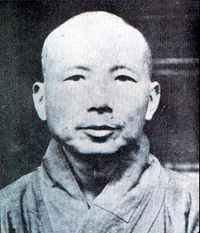Views
Zōngyǎng 宗仰 (1861-1921)
|
| Notable Associates: |
|
Zōngyǎng 宗仰 (1861-1921) was a Jiāngnán 江南 monk, most famously associated with revolutionary activities in Shànghǎi 上海 in the first decade of the 20th century.
Contents |
Biography
Zōngyǎng was tonsured at age 16 (1876) under Yàokān 藥龕 at Sānfēng Temple 三峰寺 in Chángshú County 常熟縣. After ordination he studied English, Japanese, and Sanskrit, in addition to poetry, epigraphy, and painting. (He was known throughout his life for his artistic abilities.) In 1881 he received full ordination at Jiāngtiān Temple 江天寺 at Jīnshān 金山 in Zhènjiāng 鎮江. At Jiāngtiān Temple he studied under abbot Dàdìng 大定, receiving dharma transmission from him.
In 1892 Zōngyǎng accepted the invitation of Liza Roos (Mrs. Silas Hardoon 羅迦陵) to lecture at her Kalaviṇka Hermitage 頻伽精舍 on Jìng'ān Road 靜安路 in Shànghǎi 上海.
Around the time of the Hundred Days' Reform, Zōngyǎng got to know Zhāng Tàiyán 章太炎, Wú Jìnghéng 吳敬恆, and Cài Yuánpéi 蔡元培. When the latter organized the Chinese Education Association 中華教育會 in 1902, Zōngyǎng joined Cài, Jiǎng Zhìtián 蔣智田, Jiǎng Wéiqiáo 蔣維喬, Huáng Yánpéi 黃炎培, Wáng Xiǎoxú 王小徐, and others to form the group in Shànghǎi. When Cài left the group, Zōngyǎng took over as president, reorganizing the group as the Patriotic Study Society 愛國學社. This society ran boys' and girls' schools, and published the Sūbào 蘇報, to which Zōngyǎng contributed a number of articles. In December of 1903, Cài, Wú, and others associated with the Society had to flee to Japan because of what they printed in that magazine, as well as because of their other revolutionary activities. With the financial support of Liza Roos, Zōngyǎng also went to Japan.
In Japan, Zōngyǎng shared a room with Sun Yat-sen and joined his Revolutionary Alliance (tongmeng hui 同盟會). Zōngyǎng returned to China in 1908, at which point he again took up residence at Kalaviṇka Hermitage. That same year, Liza Roos, acting on Zōngyǎng's behest, paid for a printing of the Buddhist canon in 8,416 volumes. It is called the Kalaviṇka Canon 頻伽大藏經.
After the revolution of 1911 (Tàixū 太虛 was living with Zōngyǎng when it broke out), Zōngyǎng was invited by Sun Yat-sen to come to Nánjīng 南京 to participate in the government, but Zōngyǎng declined, choosing instead to go live in obscurity.
In 1914, Zōngyǎng became head monk 首座 at Jiāngtiān Temple. From 1916 to June of 1919, he practiced in sealed confinement. When his period of practice was over, he traveled to Qíxiá Mountain Temple 棲霞山寺 in Nánjīng. He initiated its reconstruction and lived out the rest of his years there.
Important Works
| This section is incomplete and more content needs to be added. You can help by contributing text, images, or suggestions. |
Notable Students
- Liza Roos (Mrs. Silas Hardoon) 羅迦陵 (a refuge disciple of Zōngyǎng)
Notes
References
- Shěn Qián 沈潛. "Lùn Huáng Zōngyǎng yǔ Pínqiězàng de jiàokān jíqí gòngxiàn 論黃宗仰與《頻伽藏》的校刊及其貢獻." Shìjiè zōngjiào yánjiù 世界宗教研究, April 2009: 41-49.
- Yú Língbō 于凌波, ed. Xiàndài Fójiào rénwù cídiǎn 現代佛教人物辭典 (A Dictionary of Modern Buddhist Persons), 2 vols. Taipei: Foguang, 2004. Pp. 1.567c-571a.
- "Zōngyǎng shàngrén zhuàn luè 宗仰上人傳略 (Summary Biography of Master Zōngyǎng)," 棲霞山志. Hong Kong, 1962. Pp. 66-71.
